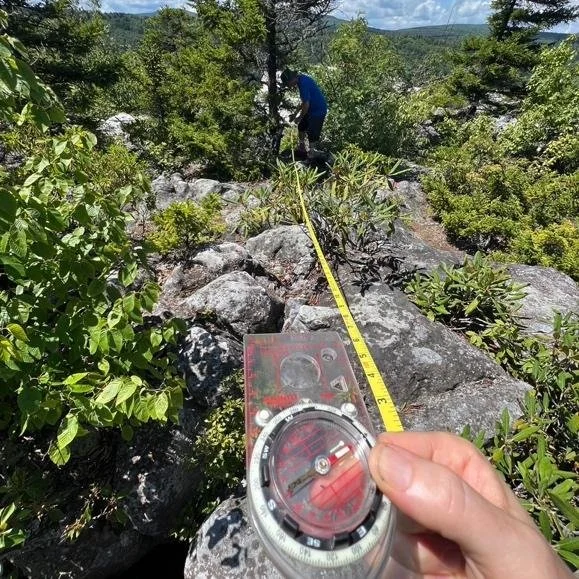Dolly Sods Campsite Inventory
Photos and article by Jill Watkins
The Potomac Chapter has offered many backpacking trips in Dolly Sods Wilderness in West Virginia over the past few years, so when the time came to volunteer in this area, AMC leaders David Mong and Jill Watkins stepped up.
The U.S. Forest Service (USFS), in partnership with the West Virginia Highlands Conservancy, is inventorying all campsites in West Virginia’s wilderness areas, including Dolly Sods, Cranberry Wilderness, and Otter Creek Wilderness. These beautiful regions in the Monongahela National Forest have never had a strong USFS presence, no regular maintenance, and like many parks and recreation areas, have become much more popular. USFS now intends to catch up on its neglect by making sure existing campsites meet Leave No Trace principles.
The initial steps include documenting known campsites, as well as finding and documenting unknown campsites. This is done by following worn paths off an established trail to see if someone has created a hidden campsite, or even checking out a cleared part of the forest to see if the clearing was created by human activity.
Once a campsite has been found, its characteristics are entered into an ArcGIS app specific to Dolly Sods. Information that is documented includes size of the campsite, groundcover disturbance, tree damage, distances from the trail and water, and its exact location using GPS coordinates. Photos are taken and a landmark identified so that a USFS staff member can find the campsite if necessary. So far, nearly 60 campsites have been documented over two weekends with a third weekend scheduled where a dozen more could be found.
Several of the seven Leave No Trace principles are likely to be addressed by the USFS. Some examples include:
Principle #2 Travel & Camp on Durable Surfaces applies to campsites created by people walking and camping on sensitive vegetation.
Principle #4 Leave What You Find addresses some campers’ propensities for chopping down trees for firewood or moving rocks from a creek to create furniture or a fire ring. (This specifically is problematic for the endangered Cheat Mountain Salamander.)
Principle #5 Minimize Campfire Impacts is one of the most important principles to be addressed for the reasons mentioned above as well as the existing of fire rings in “dry” campsites, where water is over 200 feet away.
Principle #6 Respect Wildlife also has to do with leaving trees in place (either alive or dead) as habitat for many forest animals.
Learn more about volunteering in Dolly Sods here: https://www.wvhighlands.org/dolly-sods-wilderness-stewards-form/
Learn more about Leave No Trace principles here: https://lnt.org/


